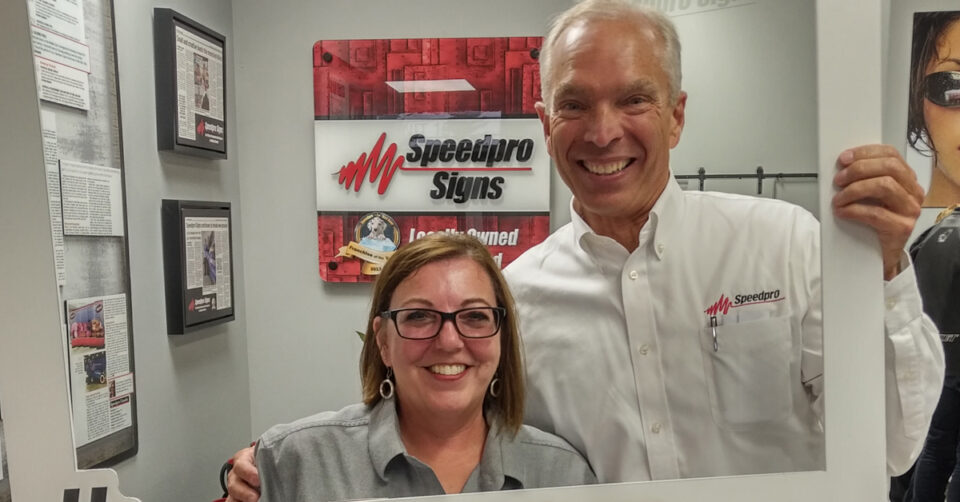How Stuart Burns’ vision helped transform SpeedPro into a top-rated company
By Roma Ihnatowycz
Stuart Burns is a man who likes a challenge. So, when he was presented with the opportunity to buy a single SpeedPro franchise, he politely declined because it was too small a business model for him at the time. Just a few months later, however, the franchisor returned with an offer to buy the whole company. That, says Burns, was more in line with the challenge he was looking for; he readily accepted.
Contrary to what many would think, Burns’ interest in SpeedPro wasn’t related to the fact that the brand was at the top of its game, expanding rapidly across the country. Instead, he felt the B2B signage brand was falling short of its full potential and had reached a bit of an impasse. Burns saw this as a wonderful opportunity to grow a successful national franchise business on his own terms.
“If the business had been winning awards, and everyone had been doing well and the growth rate had been significant, I’m not sure I would have pursued it,” Burns reflects, joking, “The only thing I could do is mess it up!”
In reality, under Burns’ discerning leadership as president, SpeedPro has almost doubled the number of its franchisees—from 25 to 47—and spread its reach across six provinces. Burns succeeded in building SpeedPro into one of the country’s leading signage companies, creating signs, banners, event displays, car wraps, and window decals for a wide range of Canadian businesses.
Four-wheel driven
Burns’ success with SpeedPro was a long time in the making. In the early part of his career, he worked in successively more senior positions in the automotive business. However, the roots of his successful career, says Burns, started even earlier—with a love of cars as a child.
“I had always loved cars as a young kid,” says Burns. “I had a passion for vehicles and my dad would take me to visit showrooms when I was around eight or nine years old. So, it was no surprise to anyone in my family that I ended up in the car business.”
After completing a business degree, Burns worked at a major automotive brand in its corporate division, selling parts, cars, and trucks. By the time he was 28, he was selling entire dealerships, before moving to head office as a retail advertising manager. Eventually, he became a sales manager for the Ontario region, responsible for hundreds of thousands of vehicle sales annually.
One day, a friend approached him and asked him to manage his biggest dealership. Ready for a change, Burns agreed, which gave him the training and skillset he needed for his next career move: purchasing his own dealership franchise, located in Winnipeg. “I ran the dealership for five years, [working] six days a week, and then took a year off to just decompress a bit,” says Burns.
It was then that the owner of SpeedPro approached him about buying his company, and Burns found himself facing yet another fork in his professional road. While he didn’t know much about the B2B signage business, he was confident that his lengthy and varied career with the auto franchise, including his time as a franchisee, primed him well for this new challenge. Everything, he says, had dovetailed perfectly.
“All of the pieces of my career had built a foundation,” comments Burns. “It gave me a great perspective in terms of understanding what franchisees needed for success. And I also had experience in sales and advertising and marketing. These were all pieces of the puzzle that led me to where I am now and into this chair.”
Building SpeedPro
After buying the business, Burns moved SpeedPro’s headquarters from Kelowna, British Columbia to Winnipeg, Manitoba (which he still calls home) and took stock of the operation. The first few years, he says, were all about building a solid foundation for growth. He spoke to franchisees to learn which aspects of the business needed improvement and started putting action plans in place.
This included bringing in a new director of operations, Jim Wernham, eliminating vendor rebates, and cancelling an ad fund—all welcome changes for franchisees. A few years in, he also took the bold step of changing the brand’s selling model to one based on exceptional, quality service rather than price.
That decision marked a major change for franchisees and a turning point for the company. Not all SpeedPro franchisees welcomed the shift, and a handful even sold their businesses. But for Burns, it presented the only way to succeed in a sector where everyone was offering essentially the same product, and all were competing on price.
“At a conference presentation I had a slide that showed a photo of a million penguins on a beach somewhere, and I said, ‘That’s our marketplace. Can you see us in there?’” says Burns. “But what nobody in the signage market had at the time is what I call a premium brand. Everyone’s reflex was just to compete on price.”
Burns set to work turning SpeedPro into that top-rated, premium-service company, and it proved an auspicious move. “In our first year after we became an exceptional service brand, we experienced the highest sales increase year we’d ever had. The momentum was there,” Burns says.
Accelerated growth
Burns also developed clear brand values to further cement the company’s business ethos and ensure new franchisees fit well into its operation. Those values are encapsulated in just three words—reliable, persistent, and intelligent. A brand alignment quiz was then developed to help the company select new franchisees.
Alignment with SpeedPro’s core values is not all that Burns looks for in new franchisees. Ideally, they should have some sales background as well, regardless of the industry. “It doesn’t matter what they were selling, but they need to be comfortable going into a meeting not necessarily knowing the people and being able to break the ice and build business trust,” he says.
Involvement in their local community is also important, through coaching sports teams or volunteering at neighbourhood events, as well as goal setting. Burns feels that people who set goals are more likely to succeed in reaching them. The size and scope of the goal, he notes, isn’t as important as the act of goal setting itself: “One applicant was avoiding telling me her goal because she thought it was shallow: she wanted to buy a convertible and had a picture of a convertible pinned in front of her desk. I thought it was fantastic!”
Burns has been steadily growing SpeedPro at a calculated rate of about two to four new franchises a year, a pace he is comfortable with. Expansion plans include opening SpeedPro shops in all 10 provinces and three territories; however, Burns stresses he’s less focused on building a large network and more on building a successful one. “I’d like to have representation in every province, to be fully national,” he says. “But as far as total count goes, I’m more concerned about all the locations being successful.”
When asked to reflect on SpeedPro’s success, Burns doesn’t talk about bullish marketing or effective sales strategy. Instead, he highlights the importance of building and supporting a great team. It all comes down to the people, he says, sharing a piece of advice once offered to him by a mentor: “Treat your team like gold and they’ll build you a rainbow.”


